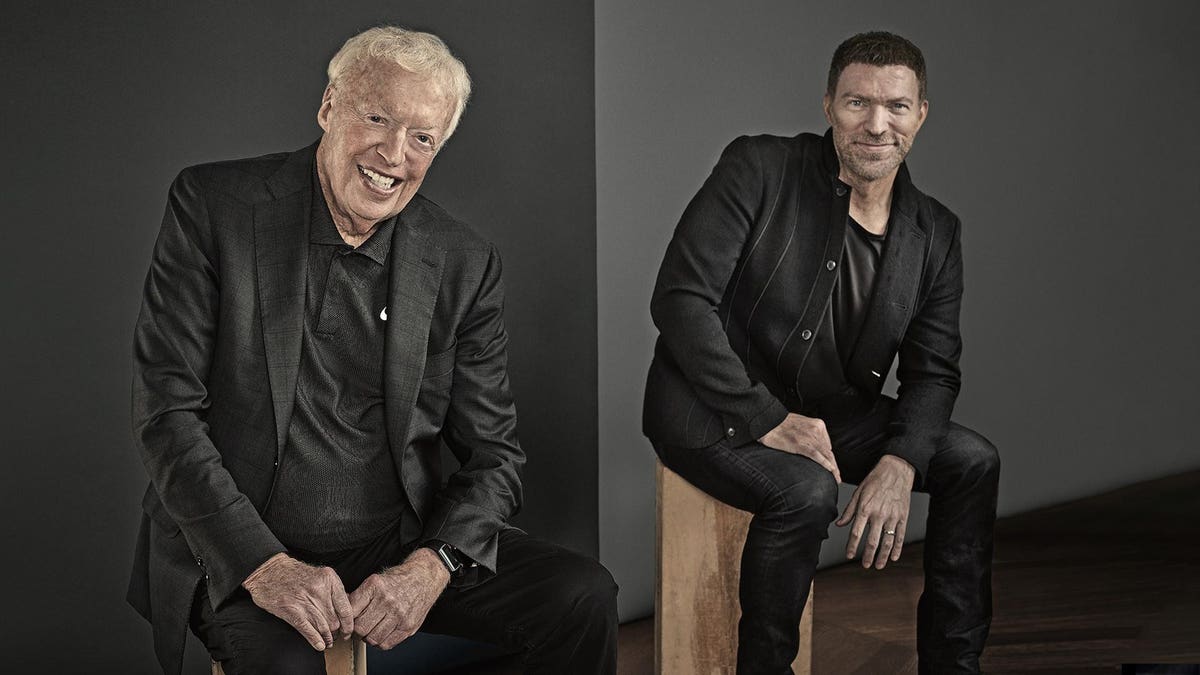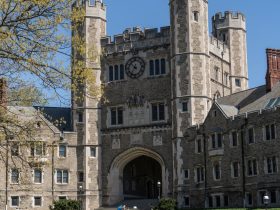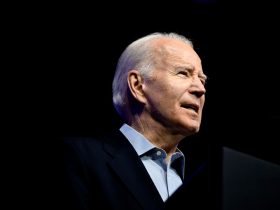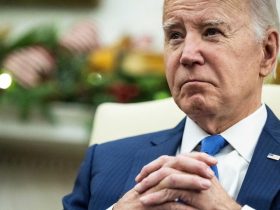Boomers and their elders control $93 trillion, or two-thirds of America’s household wealth. Forbes 400 members Phil Knight, Charles Koch, Barry Diller and Harold Hamm give a master class in how to make sure your money goes to charity and children.
By Matt Durot, Forbes Staff
“There’s four seasons in Oregon: fall, winter, spring and smoke,” laments Nike cofounder Phil Knight, 85.
Speaking in August from his home in the center of the state, he estimates that because of wildfires, visibility out his windows is limited to 100 yards. “It’s the most beautiful state in the world, so to have it devastated by smoke is heartbreaking. I’ve spent a little money looking into it, and controlling these fires on the West Coast is very doable.”
A bold claim. But Knight admits there’s a task he’s finding much harder than anticipated: giving away the bulk of his $39.5 billion fortune. “Identifying smart philanthropic bets has not been as easy as I might wish, and I expect that my successors and advisors will have a lot of wood to chop when I am no longer able to source new ideas,” he muses. “I’m not in a hurry.”
Knight is focused on ensuring family and philanthropy—not the taxman—get his wealth. There is a theoretical 40% estate tax looming, but like other members of The Forbes 400, he’s determined it won’t take a big bite from his fortune. “That’s the art form. I talk to my financial advisor all the time, and that’s one of the subjects we talk about endlessly,” he says. “My philosophy is that if I do this right, the charities I give to will use that money better than the government will. So I give to them with a completely clear conscience.” So far he has donated $3.4 billion, mainly to the University of Oregon (a science center and basketball arena), Oregon Health & Science University (a cancer research center) and Stanford (international grad student fellowships, a business school building and research on cognitive decline).
America’s Baby Boomers (born between 1946 and 1964), along with surviving members of older generations, are about to fuel the greatest wealth transfer of all time. In the U.S. today, according to the Federal Reserve, Boomers control a stunning $75 trillion and their elders another $18 trillion of the nation’s $141 trillion in total household wealth. Yes, some middle-class retirees will spend their savings and die broke. But wealth in the U.S. has become increasingly concentrated, with the richest 1% holding 31% of net assets—meaning most one-percenters (minimum net worth $10 million) will leave plenty to their children, grandchildren and favorite causes.
That’s particularly true for the very richest. Out of 88 million living Americans born before 1965, Forbes has identified 572 U.S. billionaires—the 0.000007%. We estimate they have a collective net worth of $3.9 trillion to pass on. The death tax? “Only morons pay the estate tax,” former Goldman Sachs president Gary Cohn famously quipped while serving as President Donald Trump’s chief economic advisor.
Make no mistake, the estate tax used to be a real revenue raiser. But a quarter-century of political, regulatory and court decisions—and the ingenuity of private lawyers—have eviscerated it. Congress has raised the amount that a married couple can pass on to heirs without owing estate or gift taxes from $1.35 million in 2000 to almost $26 million this year. The full $26 million can now even go into a generation-skipping or dynasty trust—meaning it can grow in value for grandkids (or later generations) without any further gift or estate tax owed. Plus, any assets someone still owns at death get a step-up in basis, so no capital gains tax is due on appreciation to that point.
The result: Only 0.04% of deaths resulted in estate taxes in 2020, down from 2.18% in 2000. True, under current law, the estate exemption will fall by about half in 2026, when the temporary Trump tax cuts from 2017 expire. But the IRS has agreed that if that happens, it won’t attempt to claw back (and then tax) money already transferred during life using the larger exemption.
For billionaires and centimillionaires, even more relief comes from an alphabet soup of wealth transfer techniques, used in ever more creative and aggressive combinations: GRATs, FLPs, IDGTs, GSTs, CLTs, ILITs, IDFs. Some plans get extra juice from intrafamily loans. Others deeply discount the value of transferred assets based on theories of why lack of marketability or control makes them worth less. In their annual menus of tax-the-rich ideas, Presidents Barack Obama and Joe Biden have proposed clamping down on some of these ploys. But that didn’t happen while Democrats held both houses of Congress. It’s a nonstarter now.
One way the rich have long been applauded for avoiding taxes is through philanthropy—far easier to love than a loophole. Industrialist Andrew Carnegie, who campaigned for the modern estate tax, gave away nearly 90% of his money—about $6 billion in current terms—before his death in 1919, leaving the balance to the nonprofit Carnegie Corp. “The man who dies thus rich dies disgraced,” he wrote in his 1889 essay “The Gospel of Wealth.”
“You want to get it to the point where when you die, your heirs don’t have to sell the company to pay taxes.”
Harold Hamm, founder, Continental Resources
In a toned-down modern version of that, Warren Buffett, Bill Gates and Melinda French Gates in 2010 created the Giving Pledge, which requires signers to devote the majority of their wealth to charitable causes during life or at death. Since then, 104 current American billionaires worth $1.5 trillion (including 77 born before 1965 who are worth $950 billion) have signed. But not all giving is purely charitable. Recently, a new breed of “social welfare” nonprofits has started clouding the meaning of philanthropy, since these organizations can engage in unlimited issue lobbying and substantial direct political activity—things traditional charities can’t do.
Here, four members of The Forbes 400 share the moves they’ve made to cement their legacies and ensure their wealth goes to family and favored causes—techniques that can work for those of lesser means, too. The four are aged 77 to 87, making them members of the (pre-Boomer) Silent Generation. They were anything but silent when discussing their legacies. Our professors are Knight; Charles Koch, the free-market libertarian worth $54.5 billion; Harold Hamm, the truck driver turned fracking king worth $25.2 billion; and TV whiz cum internet entrepreneur Barry Diller, who is the poorest at $4.1 billion—and the only Democrat. Diller is candid and unrepentant about having used a tax-saving technique he considers bad policy. “You live within the tax code, and if it says you can do this or that, and it’s in the broad mainstream, why would any sentient person act another way?”
climbs the stairs just before the sun comes up in Wichita, Kansas, to his third-floor office at the headquarters of Koch Industries, the $125 billion (2022 revenue) conglomerate of which he’s chairman and co-CEO. Overlooking him is a bust of his father, company founder Fred Koch, who died in 1967 at age 67. Charles was 32 when he took the reins.
Asked why he still works at 87, Koch invokes psychologist Abraham Maslow’s hierarchy of human needs, the highest of which is self-actualization. Then he segues into a more down-to-earth explanation. “I have retired friends at the club I belong to in Palm Springs who play nine holes every morning, have lunch and play gin all afternoon. If I did that, I’d put a bullet in my head. I wouldn’t need to because I’d be dead in six months. That’s not living.” Koch’s son Chase, 46, says his father’s passion for both business and social change keep him going. “He works out six days a week and he’s pretty healthy, knock on wood.”
That hasn’t kept Koch from nearly completing his plans for after he’s gone. He has already transferred to Chase and to daughter Elizabeth, 47, equal amounts of his nonvoting Koch shares. After Charles’ death, Chase will get all his father’s voting stock, giving him 42% control. (The heirs to Charles’ brother David, who died in 2019, also have 42%.)
This past March, Dave Robertson, 61, a Koch Industries lifer, was named co-CEO with Charles. A transition figure to Chase? “I don’t want to take anything off the table,” says Chase, who was promoted to executive vice-president in March. But he adds that his current role heading up Koch Disruptive Technologies, a venture capital subsidiary, is where he can “add the most value” now. “We don’t think about it as a family business. We think about it more as a meritocracy. As soon as we start thinking about it like ‘the next Koch needs to have this role or that role,’ I think we’re in trouble.”
Charles Koch says his kids didn’t get all his nonvoting shares; the rest will go to fund his charities and causes, after his wife, Liz, 78, is provided for. He hasn’t signed the Giving Pledge and won’t disclose the family/charity split.
But he has already made a big, and previously unreported, move. Last year he gave $4.3 billion of nonvoting Koch stock to Believe in People, a Wichita-based not-for-profit created under section 501(c)(4) of the tax code, a broad category of “social welfare” organizations that includes everything from volunteer fire companies to the National Rifle Association and the American Civil Liberties Union. In contrast to a traditional 501(c)(3) charity, a C4 can own an entire company indefinitely and (so long as these activities support its principal purpose) engage in an unlimited amount of lobbying; get directly involved in politics; and benefit private individuals.
There’s no income tax or estate tax deduction for giving money to a C4, as there is to a C3, but in 2015 Congress made a crucial tweak to the law that a Koch lobbyist promoted. That change exempted transfers to a C4 from the gift tax. So a living billionaire (or anyone else) can therefore give a C4 a big gift of highly appreciated stock without paying either gift or capital gains tax. The C4 can then sell the stock, capital gains tax–free, or hold on to it indefinitely, reaping the dividends.
While a few billionaires have put their entire companies into C4s, Koch’s $4.3 billion gift to Believe in People is the largest, in dollar terms, to a C4 that we know of. The C4 is run by Chase, Robertson and Brian Hooks, who coauthored Charles Koch’s fourth book, Believe in People: Bottom-Up Solutions for a Top-Down World (2020). Hooks, 45, also heads Stand Together, a network of Koch-funded charities and policy organizations. In addition, in 2020, Koch donated $975 million of nonvoting shares to CCKc4, a C4 run by Chase. The two newly funded C4s have as their stated purpose advancing human progress as defined in Koch’s books. Under the separate Stand Together umbrella: the nearly two-decade-old Americans for Prosperity, a C4 “grassroots” organization that has spent tens of millions a year on policy and politics, including opposing President Obama’s reelection. A political action committee affiliated with AFP is now opposing both Biden and Trump.
Koch, the staunch libertarian, has supported an array of policies that includes cutting taxes and regulations, criminal justice reform and marijuana legalization. While emphasizing that he doesn’t make the decisions at AFP, he offers this shot: “What I think is very dangerous, very destructive for our country is that both parties are becoming increasingly authoritarian.”
spending his summer yachting in the Mediterranean, Barry Diller, the founder and chairman of internet and media conglomerate IAC, returned to his Manhattan office this September to argue that the tax code is unfair to those who can’t afford a yacht. “This idea that capital deserves protection while working people’s salaries don’t is a monstrosity,” he says.
One giveaway to the rich the 81-year-old particularly hates: the grantor retained annuity trust, a popular tool for transferring appreciating assets to heirs tax-free. “GRATs should be abolished,” he says. “I’ve never heard any reason for them that has any social underpinning.” But they’re now mainstream, so he has used them. In addition to the $400 million of stock in Expedia (it was spun off from IAC) Diller currently holds in GRATs, he has transferred more than $1 billion of other assets through GRATs to different trusts for his heirs. “I’m in the center lane on this,” he says. “We don’t have lawyers looking for [new loopholes]. Some of my friends spend an excruciating amount of time on this. We don’t do that.”
One variation: the Walton GRAT, also known as a zeroed-out GRAT. Walmart cofounder Bud Walton’s ex-wife, Audrey Walton, won a tax court case in 2000 allowing it. A parent puts stock or other assets in a trust for his kids and takes back an annuity (which can pay out in stock) calculated to equal the present value of everything he just put in the trust—assuming, that is, that the assets grow no faster than a low statutory interest rate, known as the 7520 rate. That rate was an absurdly low 1.6% a year for GRATs set up in February 2022, before the Federal Reserve started raising rates. If the GRAT assets grow faster than 1.6%, there’s real wealth left in the trust for the kids (even though the parent got all his money back), gift tax–free. Because this works only if the parent outlives the term of the GRAT, this is typically done with a series of overlapping GRATs lasting two to ten years. A side benefit: The parent pays any income tax owed by the GRAT (on stock dividends or capital gains, say), effectively increasing what’s left for the kids.
Although he’s a Giving Pledge signatory, Diller still plans to leave his kids big bucks. “I believe that what Warren Buffet and others have said about not leaving your children wealthy because it ruins ambition is wrongheaded,” says Diller, who grew up in an upper-middle-class family in Beverly Hills, dropped out of college and started in the mailroom at the William Morris Agency. “They’re either ambitious or they’re not. I don’t believe money particularly motivates ambition anyway.” He himself was the wunderkind CEO of Paramount Pictures and then Fox before deciding at 50 that he wanted to own his own company.
He involves his kids in his charity work, too. “Before [the Giving Pledge] was public, Warren Buffett called and asked if we’d consider being in the initial group. I said, ‘I’ll ask my son, since he’s the one most directly affected,’ ” he recalls. That son is Prince Alex von Furstenberg, 53, one of two children from his wife’s first marriage (to a German prince). Diller married Diane von Furstenberg, the famed fashion designer, in 2000. “He’s kind of an idiot savant of investing,” Diller says of Alex, who manages the Diller–von Furstenberg family office and who urged his stepfather to sign the pledge.
So far, Diller has doled out $430 million to charity, including more than $300 million to develop Little Island, a public park on an artificial island in the Hudson River off Manhattan, with garden paths and an amphitheater. It opened in 2021 after years of legal challenges and cost overruns. The park was Diller’s baby. “I’ve always loved public art and public spaces,” he says. Alex and his sister, Princess Tatiana von Furstenberg, 52, along with their mother, serve on the board of the family’s charitable foundation; each, Diller insists, has veto power over major spending. As for the kids’ charitable interests, Alex has already spent millions of his own money promoting plans to help poor Americans build wealth. “He cares so much about inequality,” Diller says.
is a big consideration,” Phil Knight says candidly. “I suppose that’s one big reason I’m giving most of it away, because I can get more bang for my buck that way than the other way.” The other way, of course, is a chunk going to Uncle Sam in the form of estate or gift taxes. Oregon, where he’s the richest resident, also has a 16% estate tax he’s keen to avoid.
The Beaver State has benefited from his philanthropy, however, with Knight’s alma mater, the University of Oregon, the largest recipient so far. He ran track there, served a year in the Army, earned a Stanford MBA, surfed and sold encyclopedias in Hawaii on his way to Japan (where he secured U.S. import rights to a line of running shoes) and became a CPA—all before starting Nike in 1964 with his college running coach. He dismisses accusations that he has wielded excessive influence at the school. But he isn’t oblivious to criticism; it explains why he hasn’t signed the Giving Pledge. “I thought with local media being quick to criticize, they would look and say ‘You’re not giving it away very fast.’
“I don’t want to rush it. I’ve elected to focus on big causes that can have a big impact,” he adds. “It’s a bit the opposite of [Amazon founder Jeff Bezos’ ex-wife] MacKenzie Scott, who has quickly contributed so much to hundreds of different charities and done a lot of good. But there’s a lot of them in a hurry.” Responsibility for continuing his charity, Knight says, will fall first to Penny, his wife of 55 years, who “is 10 years younger than I am and in better shape.” Then son Travis, 50, will make decisions. A former rapper (stage name: Chilly Tee), Travis now runs Laika, an Oregon-based animation studio his father gained control of in 2002.
In his 2016 memoir, Shoe Dog, Knight expressed regret about not spending more time with his two sons while building Nike. (His older son, Matthew, died while scuba diving in 2004.) Now he’s spending time with Travis, talking philanthropy. That process, Knight concedes, “is actually in its infancy now, because we just started over the last couple of years to talk about those things. I’m still making the decisions, but he’s at my elbow while I’m making them.” Travis has been learning the ropes at Nike, too. In 2015 he joined the board as part of a succession plan; his dad stepped down the next year. “I’ve always felt that my position on the board is sort of as a guardian of the culture,’’ Travis says.
Knight used GRATs to move shares now worth $3.8 billion to a trust in Travis’ name. Another Knight maneuver, involving a family LLC called Swoosh, has brought the total value of shares transferred to trusts for his heirs to $4.4 billion, according to securities filings and an analysis by Bob Lord, a tax attorney and senior advisor to Patriotic Millionaires, a group favoring higher taxes on the rich.
While Travis’ trust now has voting control of the family’s nearly 20% stake (worth $29.8 billion) in Nike, 85% of the shares are technically owned by Phil Knight. Lord points out that he could use testamentary charitable lead annuity trusts (CLATs)—a well-established option—to reduce or eliminate estate tax on this remaining wealth. As with a Walton GRAT, a CLAT can be “zeroed out.” The charities get annuity payments for a fixed number of years calculated to exhaust the present value of the assets put into the CLAT—assuming they don’t earn more than that low 7520 interest rate. If they do earn more, heirs are left with the trust’s remaining assets at the end, without any estate taxes. A spokesman for Knight acknowledges CLATs are a “viable option,” but adds that “no such plan is presently contemplated.”
Knight could also leave those shares to his wife estate tax–free (under the unlimited marital exemption) and defer further planning to her. When asked what percentage of his wealth he’ll leave to charity, he tells Forbes, “It’s certainly way more than 51%. It’s certainly not 90%. It’s somewhere in between. Ultimately those final decisions will be decided after I’m gone. Penny and Travis are on the same page, and they will make the decisions on a lot of the amount that’s given.”
drive him at all,” says Shelly Lambertz, Continental Resources’ chief culture and administrative officer, of her 77-year-old father, Harold Hamm, the business’ founder. “He loves the company. It’s his first and favorite child. His identity.” Hamm, the 13th child of Oklahoma sharecroppers, picked cotton barefoot, worked as an oil field truck driver after high school, began drilling wells when he was 25 and went on to lead America’s fracking revolution.
He says his top priority right now is generating cash to pay off the $4.3 billion he borrowed to take Continental private in a $27 billion (enterprise value) LBO last November. By then, he had already transferred half the family’s Continental stake (now worth an estimated $25 billion) to trusts benefiting his five children. That took 25 years of working with lawyers and a complicated series of transactions that involved a family LLC, loans to the trusts and valuation discounts. “The biggest key is to start early, when the company is small, before the growth has occurred and the value is created,” he says. “You want to get it to the point where when you die, [your heirs] don’t have to sell the company to pay taxes.” Going private wasn’t an estate planning move, he notes, but an economic decision based on the market acting “like oil and gas didn’t exist anymore after 2020.”
So far, Hamm has donated around $200 million—less than 1% of his wealth—to charity for diabetes research, an energy institute and other causes. In 2011, he signed the Giving Pledge with his second wife; three years later he wrote her a $975 million divorce settlement check and swore never to remarry. He’s no keener to share with the IRS. “I haven’t seen anything to lead me to believe that the government has done very well with the money America has already given them.”
Additional reporting by Chris Helman
MORE FROM FORBES
Read the full article here













Leave a Reply